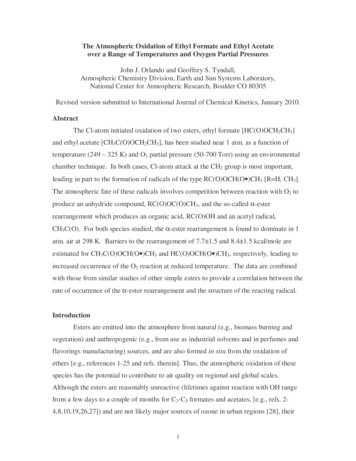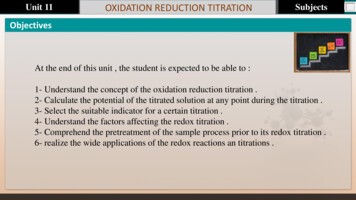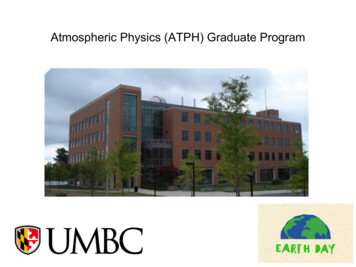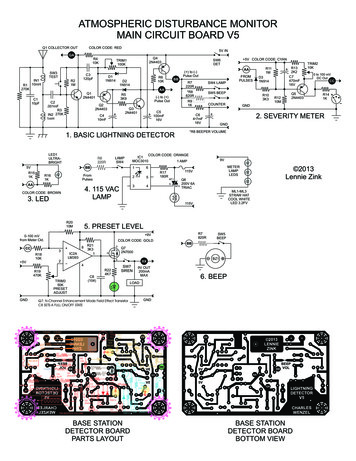
Transcription
The Atmospheric Oxidation of Ethyl Formate and Ethyl Acetateover a Range of Temperatures and Oxygen Partial PressuresJohn J. Orlando and Geoffrey S. Tyndall,Atmospheric Chemistry Division, Earth and Sun Systems Laboratory,National Center for Atmospheric Research, Boulder CO 80305Revised version submitted to International Journal of Chemical Kinetics, January 2010.AbstractThe Cl-atom initiated oxidation of two esters, ethyl formate [HC(O)OCH2CH3]and ethyl acetate [CH3C(O)OCH2CH3], has been studied near 1 atm. as a function oftemperature (249 – 325 K) and O2 partial pressure (50-700 Torr) using an environmentalchamber technique. In both cases, Cl-atom attack at the CH2 group is most important,leading in part to the formation of radicals of the type RC(O)OCH(O )CH3 [R H, CH3].The atmospheric fate of these radicals involves competition between reaction with O2 toproduce an anhydride compound, RC(O)OC(O)CH3, and the so-called α-esterrearrangement which produces an organic acid, RC(O)OH and an acetyl radical,CH3C(O). For both species studied, the α-ester rearrangement is found to dominate in 1atm. air at 298 K. Barriers to the rearrangement of 7.7 1.5 and 8.4 1.5 kcal/mole areestimated for CH3C(O)OCH(O )CH3 and HC(O)OCH(O )CH3, respectively, leading toincreased occurrence of the O2 reaction at reduced temperature. The data are combinedwith those from similar studies of other simple esters to provide a correlation between therate of occurrence of the α-ester rearrangement and the structure of the reacting radical.IntroductionEsters are emitted into the atmosphere from natural (e.g., biomass burning andvegetation) and anthropogenic (e.g., from use as industrial solvents and in perfumes andflavorings manufacturing) sources, and are also formed in situ from the oxidation ofethers [e.g., references 1-25 and refs. therein]. Thus, the atmospheric oxidation of thesespecies has the potential to contribute to air quality on regional and global scales.Although the esters are reasonably unreactive (lifetimes against reaction with OH rangefrom a few days to a couple of months for C3-C5 formates and acetates, [e.g., refs. 24,8,10,19,26,27]) and are not likely major sources of ozone in urban regions [28], their1
main oxidation products are often soluble organic acids and acid anhydrides [5-15,25,29]which may contribute to the atmospheric buildup of condensed-phase organic mass.As with most volatile organic compounds, atmospheric oxidation will be initiatedmainly by reaction with OH, and will lead to the production of a peroxy, andsubsequently an alkoxy radical, as shown below for a generic ester, RC(O)OCH2R′ [30]:OH RC( O)OCH2R′ ( O2) RC( O)OCH(OO )R′ H2ORC( O)OCH(OO )R′ NO RC( O)OCH(O )R′ NO2A key step in the oxidation of the esters, and the major source of the organic acids, is theso-called α-ester rearrangement [5] of the alkoxy radical, which can occur in competitionwith reaction of the alkoxy species with O2, e.g., :RC( O)OCH(O )R′ RC( O)OH R′C ORC( O)OCH(O )R′ O2 RC( O)OC( O)R′ HO2The α-ester rearrangement process was first discovered by Tuazon et al. [5] in their studyof the atmospheric oxidation of ethyl, isopropyl, and t-butyl acetate, and its occurrencehas subsequently been confirmed in theoretical [13,14] and experimental [7-12,15,25]studies of these and other esters, including methyl and ethyl formate, methyl acetate,methyl propionate, methyl pivalate, n-propyl acetate and isobutyl acetate. Although it isnow apparent that the α-ester rearrangement occurs more rapidly for larger and moresubstituted alkoxy radicals, there is still limited information available regarding theenergetics and dynamics of this process for the suite of atmospherically relevant esters.In this paper, we describe an environmental chamber study of the oxidation ofethyl formate and ethyl acetate, the major products of the atmospheric oxidation ofdiethyl ether [16,18,20,31]. These studies were carried out over a range of temperatures(249-325 K) and O2 partial pressures (50-700 Torr) to examine competition, underconditions relevant to the lower atmosphere, between the α-ester rearrangement andreaction with O2 for the HC(O)OCH(O )CH3 and CH3C(O)OCH(O )CH3 radicalsderived from ethyl formate and ethyl acetate. The data allow activation barriers to the αester rearrangement to be determined, and these values are compared to previousestimates [13-15] for related species.2
ExperimentalExperiments were carried out using a 2 m long, 47 L stainless steel environmentalchamber system, that has been described previously [15,31,32]. The chambertemperature was controlled using either chilled ethanol (T 298 K) or heated water (T 298 K) that was flowed through a jacket surrounding the cell from temperature-regulatedcirculating baths. Analysis of the gas mixtures in the chamber was conducted usingFourier transform infrared (FTIR) spectroscopy. Multi-pass optics (modified Hanst-type)housed within the chamber provided an infrared observational path of 32 m. Infraredspectra were recorded over the range 800-3900 cm-1, and were obtained at a resolution of1 cm-1 from the co-addition of 200 scans (acquisition time 3-4 minutes).Experiments involved the irradiation of mixtures of Cl2 (14-51 x 1015 moleculecm-3) and the parent ester (0.9-2.5 x 1014 molecule cm-3) in O2 (50-700 Torr) / N2(balance) buffer gas at total pressures of 720-770 Torr, and at temperatures ranging from249 to 325 K. Minor components of the gas mixtures were flushed into the chamber fromsmaller calibrated volumes using a flow of N2, while the O2 was added directly to thechamber. A Xe-arc lamp, filtered to provide radiation in the 240-400 nm range, was usedto photolyze Cl2 and thus initiate the chemistry. Typically, mixtures were photolyzed for4-6 periods, each of duration 15-200 s, and an infrared spectrum was recorded after eachphotolysis period. In limited cases, to minimize heterogeneous loss of reaction products,gas mixtures were photolyzed continuously and IR spectra were recorded sequentiallythroughout the photolysis period.Quantification of the parent esters (ethyl formate or ethyl acetate) and most majorproducts [formic acid (FA), CO, CO2, acetic acid, and acetic acid anhydride (AAn)] wascarried out using standard spectra recorded on our system at the temperature at which theexperiments were conducted. Quantification of formic acid anhydride (FAn) and aceticformic anhydride (AFAn), both products of ethyl formate oxidation, was via integratedband intensities obtained from room temperature reference spectrum provided by TimWallington, Ford Motor Company. Some minor products (e.g., CH3OH, CH2O, peraceticacid and acetic acid) were quantified via comparison with reference spectra obtained at298 K.3
A series of control experiments revealed that the two esters under investigationwere not subject to significant heterogeneous loss in the chamber, and were notphotolyzed over the time period of experiments conducted herein. While heterogeneouslosses of most major products were minor, it was observed that formic acid, a majorproduct of ethyl formate oxidation, was prone to significant heterogeneous loss. Tominimize this loss, many experiments were conducted using the “continuous photolysis”method described above. In most cases, corrections (usually 10%) were made toaccount for this loss. However, results from some early experiments, in which nocorrections were made, were indistinguishable from later experiments and were used inthe analysis. Quantitative analyses to be presented in this paper are based primarily onyields of formic acid (FA) and AFAn (from ethyl formate) or acetic acid and AAn (fromethyl acetate). These product species are known (or estimated) to react approximately100 times slower with Cl-atoms than do the parent esters [7,22-24,29,33-36]; hence, nocorrection for secondary loss of these product species was required.Chemicals used in this study were from the following sources: Cl2 (Matheson,UHP); ethyl formate (97%), ethyl acetate (99.5 %), acetic acid (99.8%), formic acid(95%), acetic acid anhydride (98% ), all Sigma-Aldrich; O2 (U.S. Welding); N2, (boil-offfrom liquid N2, U.S. Welding). Gases (Cl2, N2, O2) were used as received, liquids (ethylformate, ethyl acetate, acetic acid, formic acid, acetic acid anhydride) were subjected toseveral freeze-pump-thaw cycles before use.Results and Discussion1) Ethyl Formate at 298 KProducts identified in the Cl-atom initiated oxidation of ethyl formate at 298 Kincluded CO2, CO, FA, AFAn, peracetic acid, formic acid anhydride (FAn), and in somecases trace amounts of formaldehyde and possibly trace amounts of acetic acid andmethanol. On average, these products accounted for about 86 15% of the reacted ethylformate on a carbon basis. Results from typical experiments carried out at 298 K in 1atm air, plotted as observed product concentrations versus ethyl formate consumption(appearance profiles), are displayed in Figure 1. The appearance profiles for CO2, CO,formic acid, AFAn, and peracetic acid appear linear within experimental uncertainty,4
indicating that these may be primary products. However, consideration of the chemistryinvolved shows that some of the CO and CO2 results from rapid consumption of reactivefirst-generation products, such as formaldehyde and acetaldehyde. After removal ofspectral features due to known products, residual absorption features remained in theproduct spectra at 1115, 1166, 1345, 1455, and 1773 cm-1. Likely contributors to theunidentified absorption features (and to the missing carbon) include hydroperoxides,carbonyls and alcohols that can be obtained from molecular channels of peroxy radicalreactions, as discussed in more detail below.Yields of most products were found to be dependent on O2 partial pressure (seeTable 1). Yields of FA, CO2 and CO decreased with increasing O2, while those of AFAnand FAn increased. As is quantitatively discussed below, the majority of these effectsstem from the HC(O)OCH(O )CH3 species, whose chemistry involves competitionbetween O2 reaction to form AFAn and α-ester rearrangement to, in essence, form FA,CO and CO2.To quantitatively determine the origin of the identified products, and to examinethe origin of the O2 dependence of their yields, the branching ratios to the three possiblesites of Cl-atom attack on ethyl formate must first be determined:Cl HC(O)OCH2CH3 C(O)OCH2CH3 HCl(1a)Cl HC(O)OCH2CH3 HC(O)OCH CH3 HCl(1b)Cl HC(O)OCH2CH3 HC(O)OCH2CH2 HCl(1c)To determine the branching ratio to reaction at the formate group, reaction (1a),experiments were conducted with NO2 (3.5-7 x 1014 molecule cm-3) added to standardCl2/ethyl formate/air mixtures. Under these conditions, the radical product of reaction(1a) is converted quantitatively to a stable PAN-type compound [9,25], designated hereas ethoxyPAN or EoPAN:Cl HC(O)OCH2CH3 C(O)OCH2CH3 HCl(1a) C(O)OCH2CH3 O2 O2C(O)OCH2CH3(2a) O2C(O)OCH2CH3 NO2 O2NO2C(O)OCH2CH3 (EoPAN)(3a)Formation of the EoPAN will be accompanied by the production of less thermally stablealkyl peroxynitrates, as shown below for channel (1b):Cl HC(O)OCH2CH3 HC(O)OCH CH3 HCl5(1b)
HC(O)OCH CH3 O2 HC(O)OCH(OO )CH3 NO2 HC(O)OCH(OO )CH3(2b)HC(O)OCH(OONO2)CH3(3b)To allow separation of the spectral contributions of EoPAN and the alkyl peroxynitrates,excess NO (7-55 x 1014 molecule cm-3) was added to the photolyzed mixtures to removethe alkylperoxynitrate species, e.g.,HC(O)OCH(OONO2)CH3HC(O)OCH(OO )CH3 NO2(-3b)HC(O)OCH(OO )CH3 NO HC(O)OCH(O )CH3 NO2(4b)HC(O)OCH(O )CH3Products After proper accounting for products generated following NO addition (FA, AFAn andPAN, see below), as well as inorganic species such as ClNO2 and ClNO, spectral featurescentered at 1166, 1224, 1300, 1745, and 1835 cm-1 could be assigned to EoPAN whilemajor alkyl peroxynitrate features were found at 1100, 1160, 1300, 1727 and 1762 cm-1.These features correspond very closely to those attributed [9,37] to the analogous speciesgenerated from methyl formate oxidation in the presence of NO2, O2NO2C(O)OCH3 andHC(O)OCH2OONO2. The EoPAN band positions and relative intensities also agree quitewell with those reported by Malanca et al. [25] in a recent study of ethyl formateoxidation, the one exception being the 1166 cm-1 band which is absent in the Malanca etal. [25] spectrum. Given this fact, it is likely that the 1166 cm-1 band is then due not toEoPAN, but to the presence in our spectra of other multi-functional nitrates or nitritesderived from oxidation of the ethyl group. Note also that, as shown below, most of theCl-atom reaction occurs at the -CH2- group in ethyl formate and thus the majorcontributor to the alkylperoxynitrate absorption spectrum is expected to be theHC(O)OCH(OONO2)CH3 species.Determination of the branching ratio to pathway (1a) then requires quantificationof the EoPAN formed versus loss of the parent ethyl formate. Spectra of the PANspecies formed from methyl, isopropyl and t-butyl formate oxidation in the presence ofNO2 are available from work in our laboratory [9,38], and all show integrated bandstrengths (for the band centered near 1830 cm-1) of (3.9 0.8) x 10-17 cm molecule-1 andpeak cross sections for this band of (1.9 0.4) x 10-18 cm2 molecule-1 Use of these valuesfor EoPAN quantification allows us to conclude that 18 5% of the reaction of Cl-atomswith ethyl formate occurs via pathway (1a). Equivalently, given k1 1.0 10-11 cm36
molecule-1 s-1 [22-24,29,33], then k1a (1.8 0.5) 10-12 cm3 molecule-1 s-1. This result,however, appears to disagree with the yield of EoPAN (and hence the branching toabstraction of the formyl H-atom) reported by Malanca et al. [25], (44 5%) branchingratio reported in their study compared with our (18 5%) value. However, comparisonsof the cross sections used in our work with those of Malanca et al. (provided by theauthors of that study via private communication) reveals that their values are roughly afact
products [formic acid (FA), CO, CO 2, acetic acid, and acetic acid anhydride (AAn)] was carried out using standard spectra recorded on our system at the temperature at which the experiments were conducted. Quantification of formic acid anhydride (FAn) and acetic formic anhydride (AFAn), both products of ethyl formate oxidation, was via integrated











